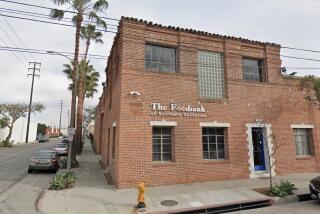COLUMN ONE : Trading in Fraud and Despair : Food stamps have become the currency of the street, fueling a vast illegal market in drugs, guns and cash.
- Share via
DALLAS — Winter whipped into town the other day riding a norther down from Canada. But the bitter cold didn’t keep the crack dealers indoors at the sprawling west Dallas housing project where the Rev. R.T. Conley was making his rounds.
“See,” he said, pointing to a group of men shivering on the porch of a boarded-up apartment. “The crack dealers are always at their posts.”
It was because of the crack dealers that the 57-year-old Baptist minister was there. Twice a week, he picks up as many children as his old brown van will carry in three trips and takes them back to his church, where he and his wife and a handful of volunteers feed them.
The reason: Crack-addicted mothers in the projects were bartering away the groceries he used to give away. They traded the food for drugs, the same as they were doing with government-issued food stamps.
“The children were suffering,” Conley said, while the drug dealers reaped profits from the government program.
In Dallas and in cities and towns across the nation, the $12.69-billion food stamp program has become a foundation of a vast underground economy. The stamps are used to buy everything from stolen cars to cocaine, from stolen liquor to munitions, from machine guns to children.
“You can buy anything with food stamps,” said Gordon Hardy, inspector general of the Texas Department of Human Services.
“In some areas, food stamps are the currency of the street,” said David Ray, head of the Louisville, Ky., office of the U.S. Secret Service.
In Albuquerque, undercover policemen last year were offered two surface-to-air missiles in trade for food stamps.
In Kansas City, Mo., a woman pleaded guilty this year to a variety of charges after an undercover police officer paid her $10,000 in food stamps for 32 ounces of PCP. Investigators said she had links to both the Bloods and Crips street gangs and made regular trips to Los Angeles to pick up the drug, usually paying for it partly in food stamps.
In Los Angeles, owners of the Rene Cafe, a grocery, were recently convicted of illegally trafficking in $1.6-million worth of food stamps, said Brian Haaser, assistant regional inspector general for the U.S. Department of Agriculture’s western region, based in San Francisco. “I see a continuing problem, and we don’t have the adequate resources” to stop it, he said.
In all, an estimated $372 million in food stamps is lost each year to fraud, theft and system inefficiencies, according to one government report. Officials of the Department of Agriculture, which administers the program, say no comprehensive studies have been done on the amount lost through fraud alone, but limited studies have suggested the figure is 1%, or $127 million annually. Some investigators think that figure is too low.
“That’s how many people they catch,” said Richard Allen, an Agriculture Department regional inspector general based in Atlanta.
“From our investigation here,” said Don Bell, a former Secret Service agent who spearheaded an undercover fraud investigation in Louisville, Ky., “I would say that it has to be somewhere from 25% to a third of the food stamps in the Louisville area, and probably nationwide, that aren’t being used for what they’re supposed to be used for.”
Federal officials estimate that perhaps as many as half the food stamp recipients in Los Angeles County are approached by people wanting to buy stamps at half their face value. The buyers wait outside of food stamp centers for prospective sellers.
Food stamps are as welcome as cash in many quarters of the criminal underworld. “If you’re dealing in stolen property or drugs, my goodness, why should you be concerned about violating food stamp laws,” said Hardy, the Texas Department of Human Resources official. “If you have a drug dealer taking food stamps for crack, you don’t have a food stamp problem,” he added. “You have a drug problem.”
Law enforcement officials across the country said it is easy to find merchants who are willing to illegally convert food stamps to dollars.
“You can go into virtually any urban area of the country, even into medium-sized towns here in Georgia with 25,000 people, and you can find this problem--you can find stores that are cheating the system,” Allen said.
Food stamp fraud is committed in smaller rural communities, too, he said, but it is more difficult to catch there.
Unscrupulous store owners usually pay half or perhaps even a smaller fraction of the face value for the stamps, which they then turn in to banks at full value, making profits of 50% or more.
Street Currency
“That’s how some of (the stores in depressed areas) keep their heads above water,” said Gary Davis, a Phoenix police detective who conducted a yearlong investigation. “Some of these markets are having a hard time. If they go under, I don’t know what the people who live in these areas would do.”
He added that food stamps are a popular street currency also because they’re very difficult to trace.
A total of $12.69 billion in food stamps is issued yearly to 18.7 million Americans, or one out of every 13 people in the nation, according to the government’s figures. The coupons are used only once. When they’re turned in, they are burned. The government keeps pumping out more than 2 billion coupons each year. “The serial numbers on them don’t mean a thing,” Davis said.
In Albuquerque, police stumbled on the black market in food stamps by accident. They were trying to catch car thieves. But, when investigators set up a sting using an auto-detailing business as a front, “people started bringing food stamps to us, and they started asking us to pay for stolen cars with food stamps,” said Capt. Cliff Jenkins of the criminal investigations bureau.
“They said food stamps were less traceable and that they had a complete underground black market set up to handle food stamps,” he said.
The police got in touch with the Department of Agriculture, which supplied officers with the stamps. During the year that the undercover operation was in business, the police traded $100,000 worth of food stamps for $436,000 in cash, cars, cocaine, marijuana, plastic explosives and automatic assault rifles. Fifty-two people were implicated. So far, 37 have been convicted.
“We knew that there was a black market dealing in food stamps,” Jenkins said, “but we had no idea it was that large.”
“You don’t just have welfare mothers trading in their monthly stamps for cash,” said Allen, referring to how the food stamps enter the underground economy. “You have everyday armed robbers and burglars who are stealing purses off of women . . . . Cash is probably their primary objective, but food stamps are their secondary objective because they’re so easy to use.
“You have people stealing stamps from mailboxes, you have postal employees stealing stamps and you have large bulk-style thefts at transport facilities.”
Larger Problems
There are also cases of state and local government employees stealing stamps at the distribution level. “If you’re a pretty good case worker and if controls are lax, you can create 15 or 20 fake files and run them for a while and probably not get caught,” Allen said. “Then you can close those files and create 15 or 20 more fake files.”
Obviously, the food stamp problem goes far beyond the neglectful welfare parent who trades stamps for cash or drugs, but people who deal with the problem find such cases the most distressing.
“Some of these people are so desperate that they would sell their own children,” said Bell, the former Louisville, Ky., investigator.
One of the men arrested in the Louisville investigation, the self-styled Rev. Earl Thomas Dowell, who died before he could stand trial, had already been convicted in 1984 and was out on parole for selling the sexual services of a 10-year-old boy for $6,000 in food stamps, Bell said.
Before the Louisville investigation ended, agents received information about a woman who was willing to sell her young child for “a few thousand dollars worth of food stamps,” Bell said. “We were never able to make the contact or do anything about that one.”
‘We’re Losing Two Generations’
Conley said he has seen similar desperation in the low-income west Dallas neighborhood where his church is situated and where he lives.
Conley, an orphan who had spent part of his youth living in the streets and whose own son died of a crack overdose two years ago, said he has lived his entire life in the more desperate sections of Dallas. But, when his eyes were opened to how the lives of children were being affected by crack, even he was shocked.
“The women were being ripped off, and the children were suffering,” he said. “We’re losing two generations”--the young people who now are hooked on crack and the children they bring into the world.
Crack, more than other drugs, appears to be addicting large numbers of low-income women, say social workers and government investigators. Crack dealers, by extending credit to welfare mothers in the housing projects, are keeping them in a kind of bondage, creating in effect a captive market for their product, Conley said.
“It’s just like the old policy racket,” he said. “When these people get their check, the first thing they do is pay their money (to the crack dealer).”
Removing Temptation
Sometimes, Conley said, he sees mothers who will buy groceries with most of their food stamps as soon as they come in the mail. This is to remove the temptation to trade the stamps for drugs. “But sometimes you see them carrying bags of groceries back to the store truck” to resell them at a loss for cash.
The children who eat in Conley’s food program range in age from 2 to 15. Most of them already are well acquainted with crack and its ravages.
The other day at Conley’s tiny church, after a meal, 10-year-old Lakendrick Burns said he didn’t like living in the projects because of the danger. “There’s too much dealing,” he said. “They be shooting and there be accidents sometimes.”
A 9-year-old boy named Sammy told of the time he saw men in a blue car park in front of his house. “They had Uzis and they started shooting,” he said. “We were looking out the window.”
The dealers are “15, 16 and 17 on up,” said Larhonda Sauels, 14. “There’s one boy 5 or 6, and he’s dealing with his daddy. He be holding the stuff. When the police come, they put the rocks in the boy’s pocket.”
Conley said he started feeding children in 1987 after relatives who live in public housing told him that crack dealers “follow the mailman” on days when food stamps are delivered. He checked it out for himself, he said, and saw the dealers come out en masse on food stamp day, pulling their cars up onto the sidewalks to transact business.
“I saw mothers coming out and lining up, handing over their food stamps,” he said. “I was sitting there in the church bus, looking right at them, but they didn’t care.”
Around this time, he said, a young woman from the projects called him and said she needed groceries because her three children were hungry. When he asked what had happened to the food stamps that he knew she had received the previous day, he said she told him they had already eaten the food they’d bought.
‘Harsh Love’
The preacher practices what could be called “harsh love” with the members of his west Dallas flock. When he went to the woman’s barely furnished apartment and found the cabinets and the refrigerator empty, he admonished her until he said she broke down weeping, admitting finally that she had traded the stamps for crack. “She said, ‘I need help,’ ” Conley recounted.
Ira Colby, a social worker and director of the criminal justice program at the University of Texas at Arlington, said such abuses represent a small minority of the food stamp program.
Most of the food stamps that enter the underground economy from individuals on welfare are traded, not for crack, but for necessities of life, he said. Government guidelines set the net monthly income limit for a family of four on food stamps at $971. The average per-meal/per-person benefit is 58 cents. The average monthly per-person benefit is $50.13
“This isn’t a lot of money,” said Colby. “What happens is that folks will take whatever they have to generate additional income to pay a utility bill, to put gasoline in the car, to buy a tire for the car or whatever . . . . When you’re poor, you’ll do what you have to do to make ends meet.”
Often, he said, people who sell their food stamps in order to get cash for necessities will later buy some of their food stamps back, again at a fraction of face value. “It’s like a form of loan sharking,” he said.
But, disputing the allegations of rampant fraud in the system, David Super, a policy analyst for the Food Research and Action Center in Washington, a non-governmental organization that deals with social policy issues, said, “The food stamp program has from time to time been smeared by people who are making the mistake of extrapolating to the whole program for things that happen to a few people.”
He said he believes more money is spent investigating fraud than than is actually misspent in the food stamp program.
The solution to food stamp fraud, Colby believes, would be to substitute cash for the stamps, something he does not think will happen because of opposition from the farm lobby and the stereotype he said many people have that poor people are irresponsible.
The current federal food stamp program began in the 1970s. It was intended as much to assist American farmers as it was to help feed the hungry.
Some government officials, such as Hardy of the Texas Department of Human Resources, agree that it is time for the program to switch to cash.
In San Diego County, cash already is being used instead of food stamps. Richard Jacobsen, director of the Department of Social Services there, said it is more cost effective and also removes the stigma of using food stamps.
Citing studies that showed there would be little difference in how much food would be bought with cash as opposed to food stamps, Hardy said using cash would reduce the cost of printing, shipping and distributing the coupons.
Like Colby, however, Hardy doesn’t think switching the program to cash nationally is politically feasible.
Another method currently being studied involves issuing magnetic-stripe cards, similar to credit cards, to food stamp recipients. Clients would use the cards to buy food without either cash or stamps exchanging hands.
Although he sought to downplay the amount lost annually through fraud, Scott Dunn, acting administrator of the Department of Agriculture’s food and nutrition service, said: “The use of (the cards) will provide an additional level of effort to help make sure the cards are used to purchase food instead of ineligible or illegal items.”
Trapping a Key Player
The underground food stamp economy is fueled in part by people like Steve D. Martin, the former manager of a company hired by the state of Kentucky to distribute $6 million in food stamps monthly in four counties.
Martin was convicted earlier this year in Louisville of falsifying records to hide the existence of $40,000 worth of food stamps found by investigators in a bank safe-deposit box.
In the two-year probe, investigators from the Secret Service, Department of Agriculture and the Kentucky attorney general’s office set up a survivalist food store and operated it for four months.
“We weren’t after the general population, the people who get $300 worth of food stamps and want to sell them for $150 cash,” said Bell, the former Secret Service agent who conducted the investigation. “We were only after those people who were trafficking in large quantities of food stamps.”
Investigators had to build a ladder of deception to reach Martin. There was a meat store and fruit stand next door to Martin’s food stamp distribution center. “The minute suspects walked out of the food stamp office, they would be approached by the merchants who were running the fruit stand to buy the food stamps,” Bell said.
Applying pressure, the agents forced the meat store owner to set up a meeting with Martin at the exclusive Valhalla Country Club, where Bell almost blew his cover. In the course of the six-hour get-acquainted golf game, he missed an easy shot at one point and said out loud, “Oh, Bell, what’re you doing?” He forgot that he was using the name Don Penn.
Martin didn’t hear it, luckily, and the Secret Service agent eventually was able to reach an agreement to buy stamps. When Martin backed down, his records were subpoenaed. Investigators were able to make a case against him and 11 other traffickers.
“I didn’t realize that you could just buy everything under the sun with food stamps,” said Bell of his undercover experiences. “I bought a refrigerator from a used-furniture dealer with food stamps. We bought some marijuana, cocaine, Diludid tablets, shotguns . . . . There was no end to what you could buy because they’re just as good as cash.
“This is a whole area that needs to be corrected nationwide.”
Times researcher Tracy Shryer contributed to this report.
More to Read
Sign up for Essential California
The most important California stories and recommendations in your inbox every morning.
You may occasionally receive promotional content from the Los Angeles Times.













